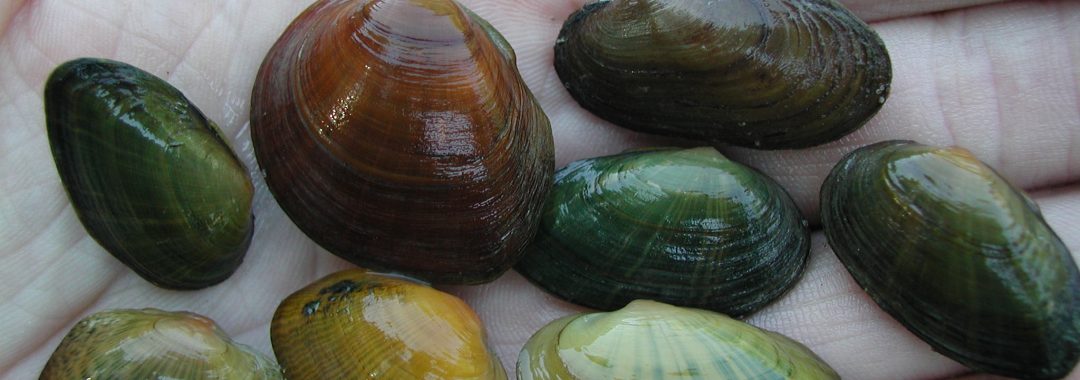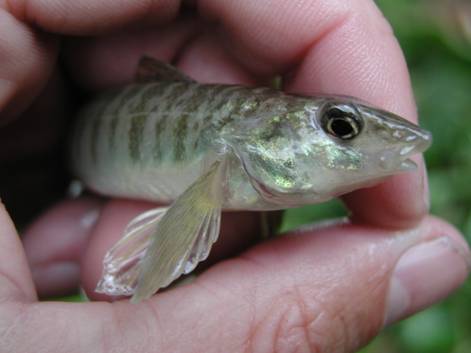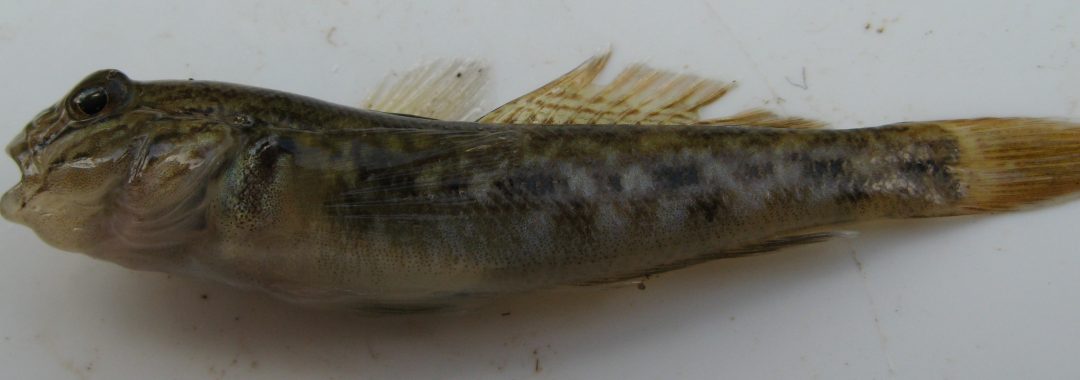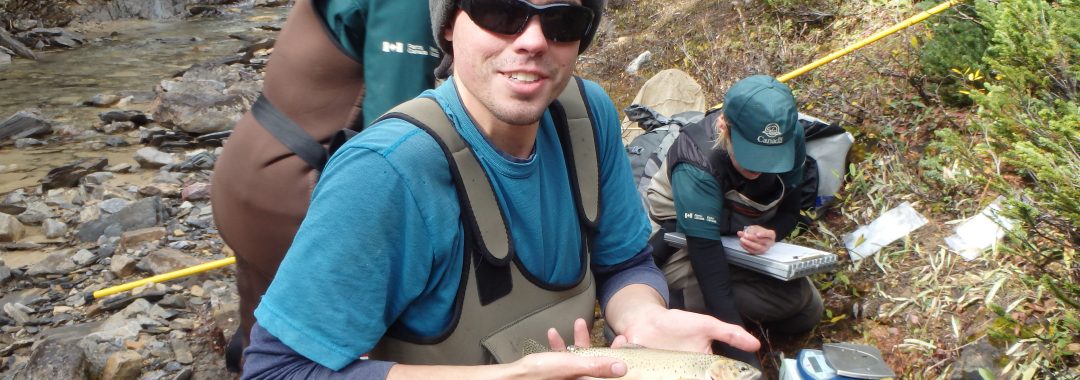The PoeschLab is thankful to the Alberta Conservation Association (ACA) for helping fund research on the Western Silvery Minnow, a species at risk. This project is being conducted by MSc student Kenton Neufeld. We thank the ACA for their support.
Category Archives: Conservation of Freshwater Fishes
Freshwater fishes are among the most imperiled groups globally with rates of decline comparable to declines in tropical rainforest species. Research in the PoeschLab focuses on developing a better understanding of the mechanisms for the decline of freshwater organisms. This research has four main themes, including: 1) threats to freshwater species at risk, 2) stream augmentation and hydrologic alteration, 3) climate change impacts to freshwater fishes, and 4) the spread and impact of invasive species. To achieve our research goals we utilize a variety of expertise in the PoeschLab and the University of Alberta. This includes expertise in: movement ecology and telemetry, assessing foodwebs using stable isotope analysis, population genetics and environmental DNA (eDNA) and morphology and swim performance.
Poesch, M.S., Lawrie, D., Tu, C., Jackson, D.A., and N.E. Mandrak (2012) Developing local and regional population estimates for an endangered freshwater minnow, the redside dace (Clinostomus elongatus), in Canada. Aquatic Conservation 22: 47-57.
Abstract:
The Laurentian Great Lakes have undergone drastic declines in freshwater fishes, with 22 species having become extinct in the past century and many more currently at risk. One such species is the endangered minnow, the redside dace (Clinostomus elongatus), which is undergoing severe declines across its entire range. Depletion and mark–recapture surveys were used to quantify population estimates of redside dace at several spatial scales (pool, reach and catchment) across several Great Lakes tributaries in Canada. There was large variation in the local population estimates and the rate of occurrence of redside dace populations. In some cases, such as Gully Creek, a Lake Huron tributary, redside dace were widespread (9/10 of pools) but in low abundances (13.5 individuals per pool ± 5.09 ). In other cases, such as in the Don River, redside dace were highly localized (2/27 pools) but in relatively high abundance (99.2 individuals/pool ± 18.1). Extrapolated population estimates at the catchment scale showed that three of the five study populations were below conservative estimates needed for long-term population viability. Differences in redside dace populations were driven by adjacent land-use. Post-hoc analyses revealed strong negative associations between population estimates and impervious land-use (i.e. urbanization) at both the pool and sub-catchment level. Immediate recovery actions that will focus on eliminating chronic and episodic impacts of adjacent land-use and improve connectivity are needed to help ensure redside dace, like many freshwater species in the Laurentian Great Lakes, remain a species at risk of – rather than facing – extinction.
Citation: Poesch, M.S., Lawrie, D., Tu, C., Jackson, D.A., and N.E. Mandrak. 2012. Developing local and regional population estimates for an endangered freshwater minnow, the redside dace (Clinostomus elongatus), in Canada. Aquatic Conservation 22: 47-57.
Also Read:
Schwalb, A.J., Cottenie, K., Poesch, M.S., and J. Ackerman (2011) Dispersal limitation in unionid mussels and implications for their recovery. Freshwater Biology 56: 1509-1518.
Abstract:
Freshwater unionid mussels are a highly imperilled group. Their dispersal abilities depend on the availability and the movement of host fish on which their parasitic mussel larvae develop. We examined the relationship between the dispersal abilities of unionid mussels and their conservation status on a regional (SW Ontario) scale and their distribution and abundance on a catchment scale (Sydenham River, SW Ontario) by determining host specificity and estimating the dispersal abilities of mussels on fish from a review of the literature. On the regional scale, we found that mussels with the most precarious conservation status relied on host fish with short movement distances, whereas vulnerable and more secure mussel species had host fish with 2–3 orders of magnitude larger movement distances. We were not able to detect a clear pattern on the catchment scale. Our results suggest that limited dispersal by host fish affects the abundance and distribution of unionid mussels and ultimately their conservation status on a regional scale. Information on dispersal limitations because of differences in host fish communities should be included in conservation and management decisions to ensure connectivity and maintain functioning mussel metacommunities.
Citation: Schwalb, A.J., Cottenie, K., Poesch, M.S., and Ackerman, J. 2011. Dispersal limitation in unionid mussels and implications for their recovery. Freshwater Biology 56: 1509-1518.
Also Read:
Schwalb, A.J., Poesch, M.S., and J. Ackerman (2011) Movement of logperch—the obligate host fish for endangered snuffbox mussels: implications for mussel dispersal. Aquatic Sciences 73: 223-231.
Abstract:
Unionid mussels are highly imperiled and the survival of their local populations is linked to the availability and dispersal potential of their host fish. We examined the displacement distance of logperch (Percina caprodes), which are obligate host fish for endangered snuffbox mussels (Epioblasma triquetra), to determine the dispersal potential by fish. Logperch in the Sydenham River, Ontario, Canada, were electrofished and marked with visible implant elastomer on five sampling dates during the gravid period of E. triquetra. The majority of all recaptures (82%) of P. caprodes occurred within 30 m of their original capture location, with a mean displacement distance of 13 ± 3 m (mean ± standard error, n = 28). These results were consistent with a review of movement studies of small benthic host fish (i.e., darters and sculpins), which revealed average fish displacement distances of 37 ± 19 m (n = 14 species; range: 4–275 m). However, significantly greater movement distances were also found and the maximum displacement distance increased significantly with the spatial extent of the study and with the duration of the study. These results indicate that many P. caprodes remain in a small area, which could restrict the dispersal and (re)colonization potential of E. triquetra. Further studies are needed to determine the dispersal potential of mussels via host fish, which may be important for maintaining the connectivity among unionid populations.
Citation: Schwalb, A.J., Poesch, M.S., and Ackerman, J. 2011. Movement of logperch—the obligate host fish for endangered snuffbox mussels: implications for mussel dispersal. Aquatic Sciences 73: 223-231.
Also Read:
Dr. Mark Poesch Redside Dace research (Roger’s News, video)
Archived Content.
Poesch, M.S., Dextrase, A.J., Schwalb, A.N., and J. Ackerman (2010) Secondary invasion of the round goby into high diversity Great Lakes tributaries and species at risk hotspots: Potential new concerns for endangered freshwater species. Biological Invasions 12: 1269-1284.
Abstract:
The round goby (Neogobius melanostomus) first invaded North America in 1990 when it was discovered in the St. Clair River. Despite more than 15 years of potential invasion, many Great Lakes’ lotic systems remained uninvaded. Recently, we captured the round goby from several Great Lakes tributaries known as species-at-risk hotspots. With a combination of field sampling of round gobies and literature review of the impact of round gobies on native taxa, we assess the potential impacts of the secondary invasion to native species using three mechanisms: competition; predation; and indirect impacts from the loss of obligate mussel hosts. We estimate that 89% (17/19) of benthic fishes and 17% (6/36) of mussels that occur in these systems are either known or suspected to be impacted by the secondary invasion of round goby. In particular, we note that the distribution of potential impacts of round goby invasion was largely associated with species with a conservation designation, including seven endangered species (1 fish, 6 mussels). As these recent captures of round goby represent novel occurrences in high diversity watersheds, understanding the potential impacts of secondary invasion to native biota is fundamental to prevent species declines and to allow early mitigation.
Featured In: Fisheries 34(9): 421 (Link), & several media outlets.
Citation: Poesch, M.S., Dextrase, A.J., Schwalb, A.N., and Ackerman, J. 2010. Secondary invasion of the round goby into high diversity Great Lakes tributaries and species at risk hotspots: Potential new concerns for endangered freshwater species. Biological Invasions 12: 1269-1284.
Also Read:
Poesch, M.S., Walker, S.C., and D.A. Jackson (2009) Functional diversity indices can be driven by methodological choices and species richness. Ecology 90(2): 341-346.
Abstract:
Functional diversity is an important concept in community ecology because it captures information on functional traits absent in measures of species diversity. One popular method of measuring functional diversity is the dendrogram-based method, FD. To calculate FD, a variety of methodological choices are required, and it has been debated about whether biological conclusions are sensitive to such choices. We studied the probability that conclusions regarding FD were sensitive, and that patterns in sensitivity were related to alpha and beta components of species richness. We developed a randomization procedure that iteratively calculated FD by assigning species into two assemblages and calculating the probability that the community with higher FD varied across methods. We found evidence of sensitivity in all five communities we examined, ranging from a probability of sensitivity of 0 (no sensitivity) to 0.976 (almost completely sensitive). Variations in these probabilities were driven by differences in alpha diversity between assemblages and not by beta diversity. Importantly, FD was most sensitive when it was most useful (i.e., when differences in alpha diversity were low). We demonstrate that trends in functional-diversity analyses can be largely driven by methodological choices or species richness, rather than functional trait information alone.
Citation: Poesch, M.S., Walker, S.C., and Jackson, D.A. 2009. Functional diversity indices can be driven by methodological choices and species richness. Ecology 90(2): 341-346.
Also Read:
Poesch, M.S., Mandrak, N.E., and R. L. McLaughlin (2008) A practical framework for selecting among single species, multi-species and ecosystem-based recovery plans. Canadian Journal for Fisheries & Aquatic Science 65: 2656-2666.
Abstract:
Science-based approaches for selecting among single-species, community-, and ecosystem-based recovery plans are needed to conserve imperilled species. Selection of recovery plans has often been based on past success rates with other taxa and systems or on economic cost, but less on the ecology of the system in question. We developed a framework for selecting a recovery plan based on the distributions and ecology of imperilled and nonimperilled species across available habitat types and applied it to fishes in the Sydenham River, Ontario, Canada. We first tested whether distributions of fishes were adequately predicted by habitat features hypothesized to limit the distributions of imperilled fishes versus a broader set of habitat features known to predict fish distributions. We then tested whether imperilled species occurred in similar or disparate habitat types. For the Sydenham River, an ecosystem-based recovery plan was deemed most appropriate because imperilled species occur in disparate habitat types. We lastly provide decision criteria to facilitate applications of our framework to the selection of recovery plans for other species and systems.
Citation: Poesch, M.S., Mandrak, N.E., and McLaughlin, R.L. 2008. A practical framework for selecting among single species, multi-species and ecosystem-based recovery plans. Canadian Journal for Fisheries & Aquatic Science 65: 2656-2666.
Also Read:
Poesch, M.S., Mandrak, N.E., and R. L. McLaughlin (2007) The effectiveness of two common sampling methods for sampling imperiled freshwater fishes. Journal of Fish Biology 70: 691-708.
Abstract:
This study tested the hypothesis that the most common gear type used to sample fishes in wadeable systems, electrofishing, was more effective than another commonly used gear type, seining, for sampling fish species at risk. Five predictions were tested. At sites where species at risk were detected, (1) the probability of detecting the species at risk, (2) the probability of only one gear type detecting the species at risk and (3) the estimated catch per unit effort of the species at risk, was as high as, or higher, when using electrofishing than when using a seine. (4) The number of sample sites required to detect a species at risk within a watershed and (5) the number of subsections required to detect a species at risk within a site, were as low as, or lower, using electrofishing than the number required using a seine. Based on analyses of these measurements, electrofishing was a more effective gear type than seining for sampling fish species at risk, irrespective of the unit (presence or absence or catch per unit effort) or scale of measurement (watershed or site level). Dissolved oxygen, turbidity, specific conductivity and nitrate concentrations were measured at each site and did not account for the between gear differences. Selection of sampling gear can be a fundamental consideration for the assessment of fish species at risk, where, unlike common species, they may be particularly influenced by small population sizes, restricted geographic ranges and narrow habitat preferences. Resource managers must weigh differences in the risks of injury of fish species at risk against differences in the effectiveness of each gear type when deciding between gear types and the utility of the assessments they represent.
Citation: Poesch, M.S., Mandrak, N.E., and McLaughlin, R.L. 2007. The effectiveness of two common sampling methods for sampling imperiled freshwater fishes. Journal of Fish Biology 70: 691-708.
Also Read:
Scott, R.J., Poesch, M.S., Noakes, D.L.G., and F.W.H. Beamish (2005) Effects of exotic salmonids on juvenile Atlantic salmon behavior. Ecology of Freshwater Fish 14: 283-288.
Abstract:
We examined the effects of two salmonid species, chinook salmon (Oncorhynchus tschwaytscha) and brown trout (Salmo trutta), both exotic species to Lake Ontario, on behaviour and foraging success of juvenile Atlantic salmon (S. salar), a native species to Lake Ontario, in an artificial stream. We found that both exotic species have effects on Atlantic salmon behaviour, but that neither had an effect on foraging success. These results may explain why the Atlantic salmon re-introduction programme in Lake Ontario has had little success, as more than 3 million exotic salmonids are released in Lake Ontario streams annually.
Citation: Scott, R.J., Poesch, M.S., Noakes, D.L.G., & Beamish, F.W.H. 2005. Effects of exotic salmonids on juvenile Atlantic salmon behavior. Ecology of Freshwater Fish 14: 283-288.
Also Read:










